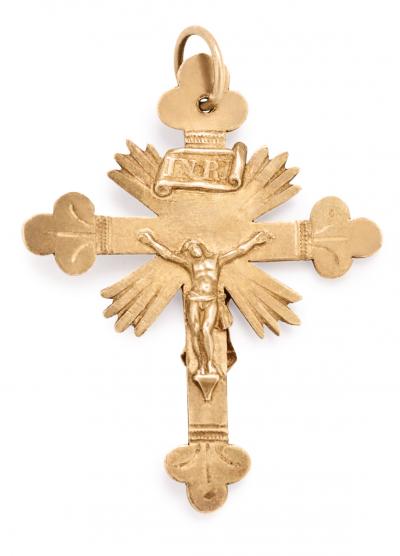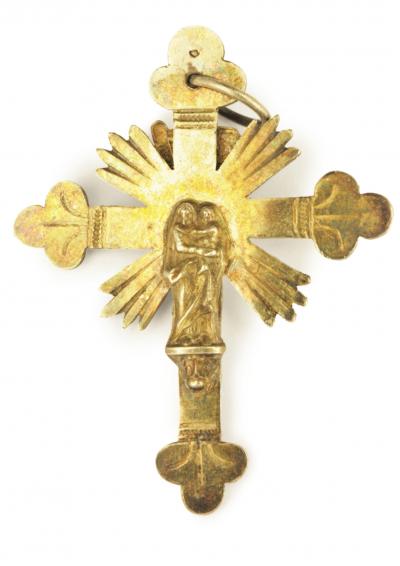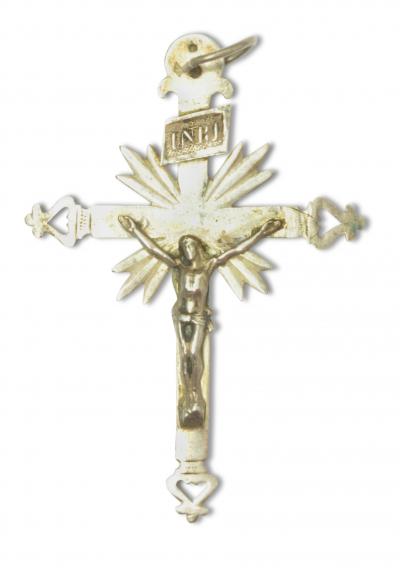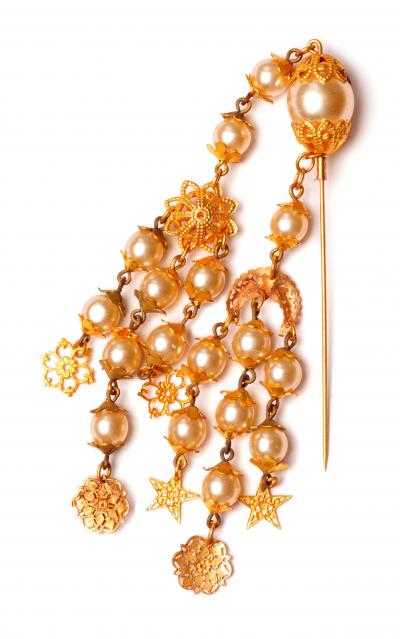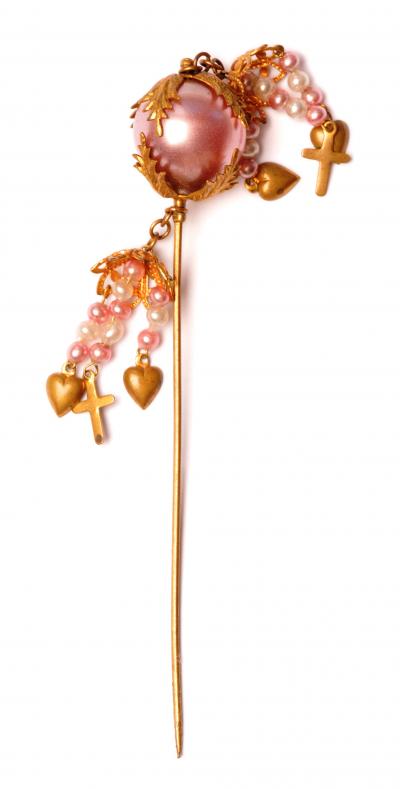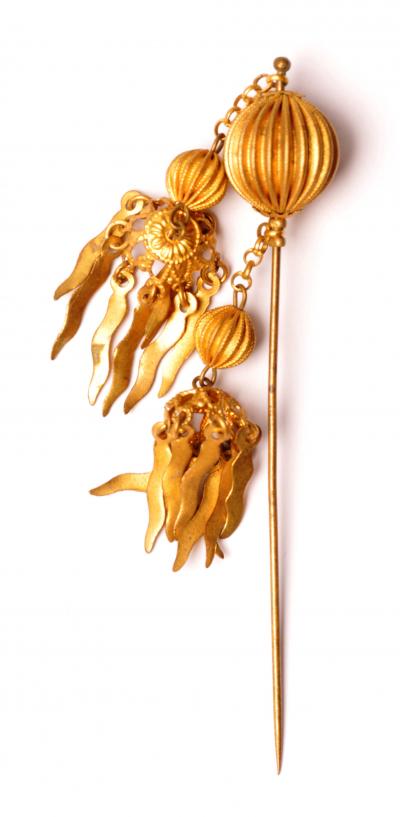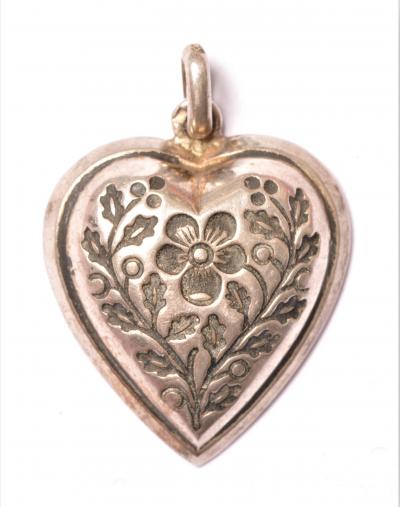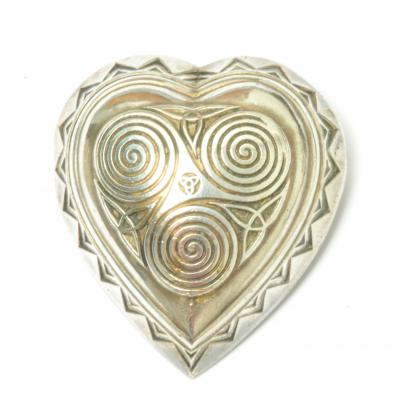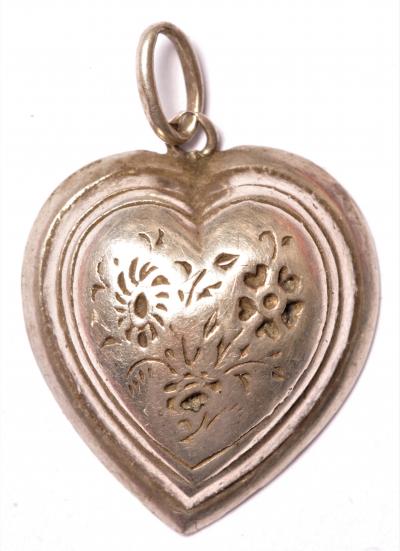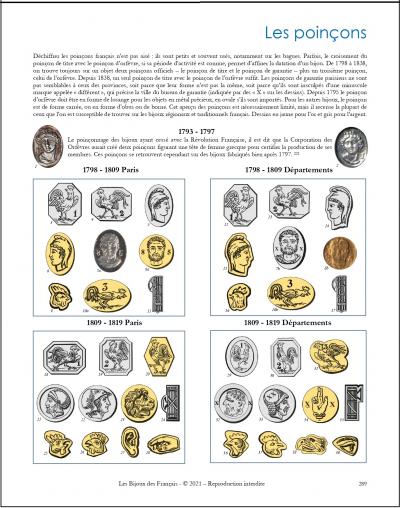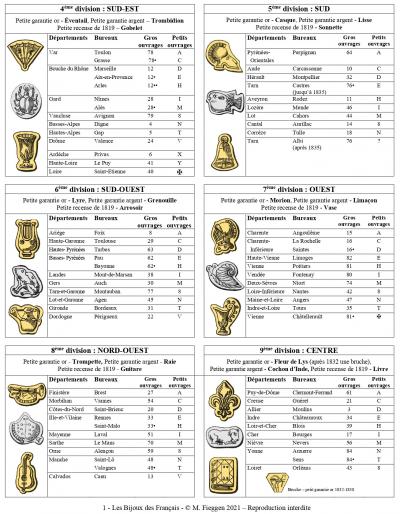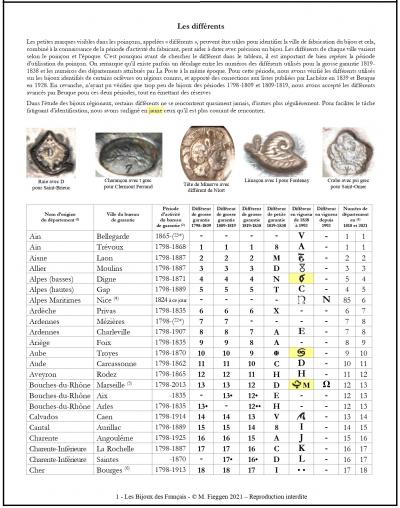Brittany

French regional jewellery - Brittany
BIJOUX REGIONAUX ANCIENS - BIJOU REGIONAL
Brittany is not a rich region for regional jewellery and the hollow and inexpensive Jeannette cross, usually made in Paris, was widely worn. There are also small “baton” crosses, although these too are not unique to Brittany. Crosses were often worn on large velvet ribbons embellished with sequins, the shine of these having apotropaic virtues (believed to "reflect" away bad luck). Silver reliquary crosses, engraved with symbols of the crucifixion, were often worn in Brittany.
It is worth noting that in areas with elaborate and richly embroidered folk costumes there are usually few jewels. This is because the regions that are isolated by transport difficulties cannot easily trade with other regions and unless the women are involved in making a high value trade item such as lace, their surplus hours cannot be profitably employed. These women will thus turn to embellishing their own clothes with intricate embroidery. Once the possibility of producing trade goods is found, the clothing becomes simpler and women "subcontract", as it were, their desire to embellish themselves by purchasing silver or gold jewellery to wear.
Note that in 1902, however, there was a crisis in the sardine industry, with a catch five times less than in previous years. 15,000 to 20,000 workers in the canneries, and twice as many fishermen were unemployed and famine stalked Brittany. The women of Concarneau, Penmarch and Douarnenez improvised in lace-making to support their families and Breton lace was born.
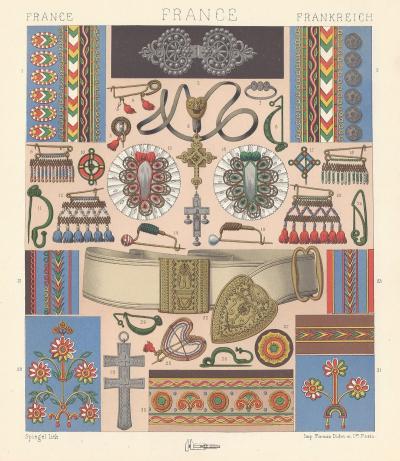
Brittany peasant embroidery and jewellery according to Racinet in La Costume Historique, 1888
click on the photos to enlarge them in high resolution
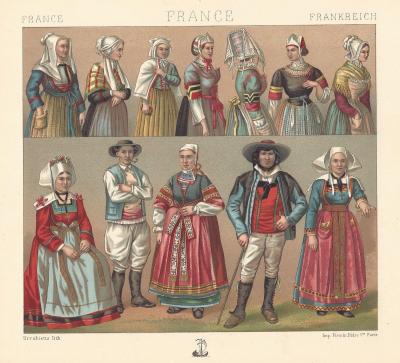
Traditional folk costumes from Brittany according to Racinet in La Costume Historique, 1888
click on the photos to enlarge them in high resolution
The faith ring
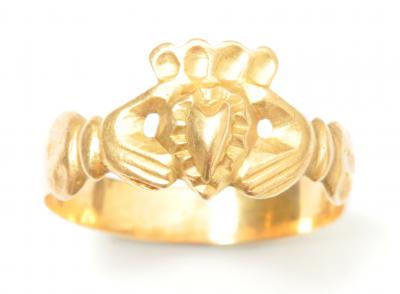
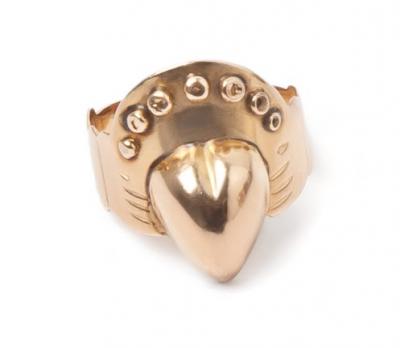
Brittany faith rings, gold
The faith rings or fede rings are closely associated with Brittany but are in fact engagement rings of Vendée origin. In Brittany they were mostly adopted by sailors. In the later versions, the two hands holding the central heart have virtually disappeared and are represented by some vestigial lines to delineate the fingers. In the 19th century the jeweler always gave to the bride along with the wedding band a small ring, called coral ring or carnelian, to avoid friction with the wedding band. Around 1908 this use still existed in some rare areas of the Vendée Maritime and Saint-Gilles but had disappeared at Les Sables d'Olonne. Lionel Bonnemère, in a conference in Paris in 1903, showed how these faith rings were exported and imitated in Congo by the natives of the country.
Saint Anne ring
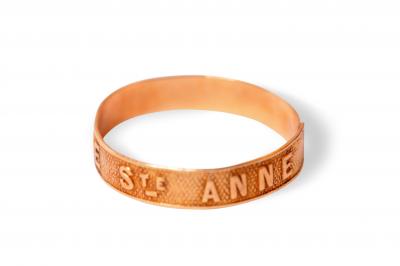
gold ring with stamped impression "Souvenir de Sainte Anne",
probably sold during the annual assembly at Saint Anne d'Auray in Brittany
(the only place in the world where Saint Anne, mother of Mary, is claimed to have appeared)
The baton cross
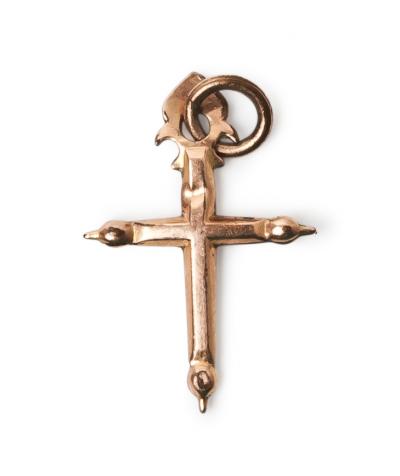
Brittany cross, gold |
|
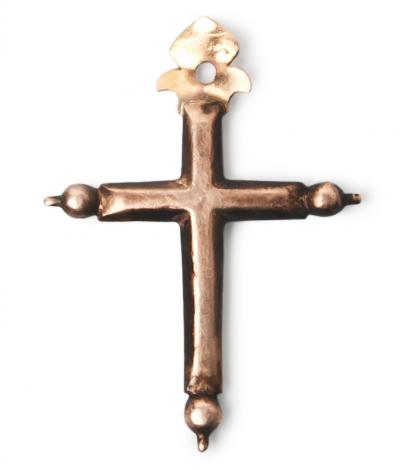
Brittany baton cross, gold |
The baton cross is a small hollow cross with a rectangular cross-section and with pointed spheres set at the end of each arm, made to represent tears and the three times Christ was said to have wept. These baton crosses were popular in Brittany but can also be found in other areas of France. They are only very rarely found with heart shaped slides.
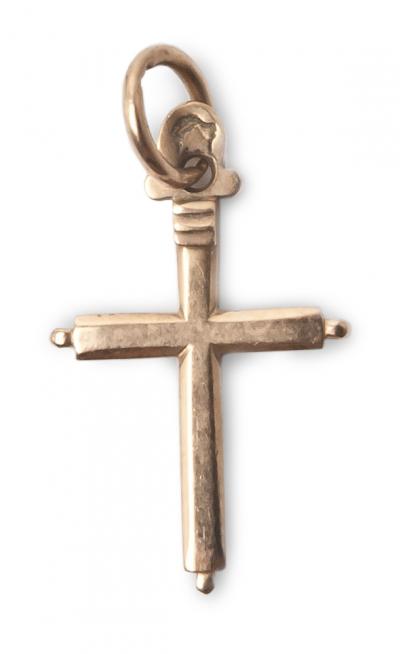
Brittany cross, gold |
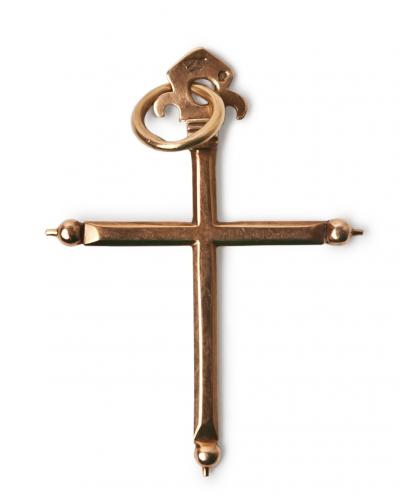
Brittany cross, gold |
The Breton flat cross
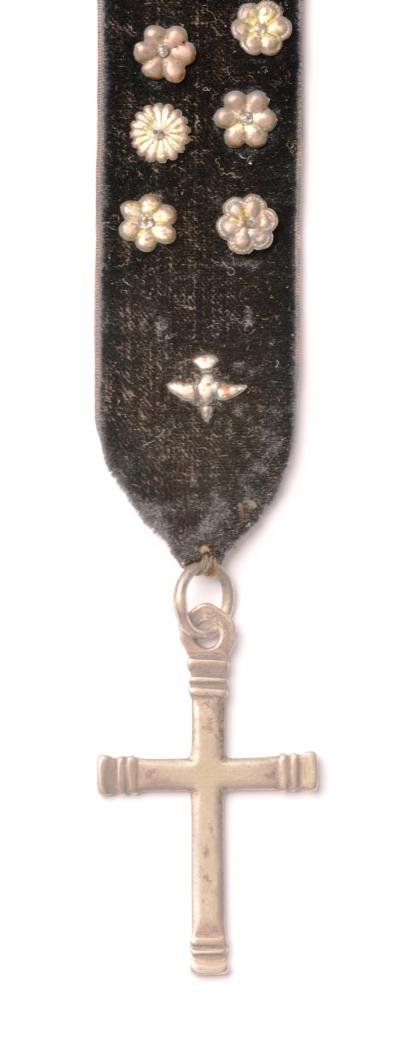
flat cross in silver, Finistère |
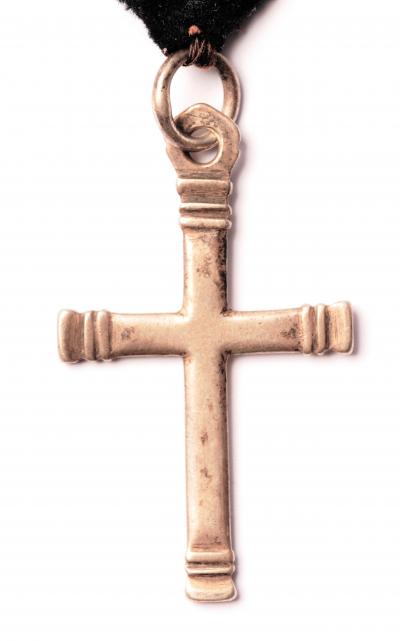
flat cross in silver, close-up, Finistère |
The Breton flat cross is made of solid silver with beveled edges and tipped with depressions and bulges.
The Jeannette cross
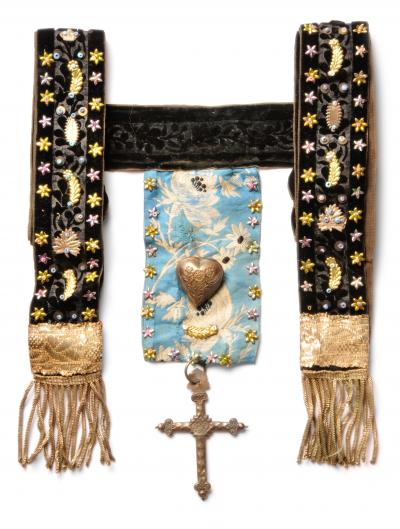
silver "Jeannette" cross from Brittany with its sequin spangled velvet ribbon
The Jeannette crosses were worn throughout France, and particularly in the regions that had not adopted a unique cross of their own. They were inexpensive, being generally of silver or of hollow, stamped gold, even gold-plated. Often produced in Paris, they were resold by local jewellers or by traveling salesmen who set up stands at the local fairs and religious gatherings.
There are two types of cross Jeannette, differentiated by the shape of the ends of the arms. Some have oval-shaped endings while others have diamond-shaped ends. Both types almost always have pointed spheres or egg-shaped tips, although lozenge shaped tips do exist.
Some of the Jeannette crosses are plain on both sides while others, illustrated on this pag have a facetted finish on one side, made to resemble a cross that has been roughly hewn with an adze. It's possible that this more sparkling side was worn outwards on Sundays and for special occasions, or perhaps the less sparkling side was worn to church. There are dozens of different designs for the central square or circle; that of a flower is the most popular and the design is often different on the other side. It seems that Jeannette crosses were worn from 1783 by all classes, then only by women in the countryside. After 1872 for a few years there was a renewed fashion for city women to wear them too, then this fashion was over and again the country women were the only ones to wear them.
In Brittany the Jeannettes crosses were often worn on velvet ribbons adorned with sequins supposed to ward off bad luck by reflecting it away. The central motifs of the cross Jeannettes are almost always square but sometimes round and are very variable - we find stars, flowers, letters, the Holy Spirit and geometric designs.
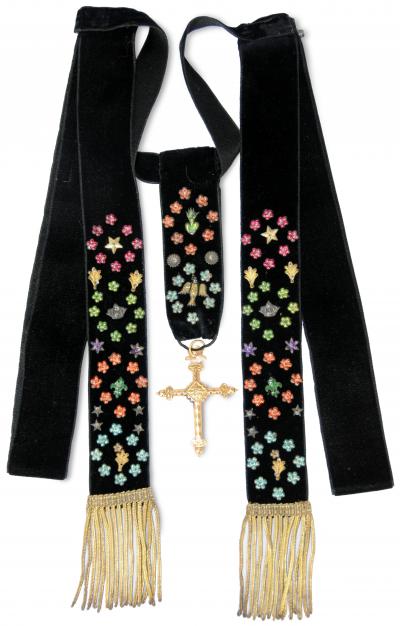
"Jeannette" cross from Brittany with its sequin spangled velvet ribbon
click on the photos to enlarge them in high resolution
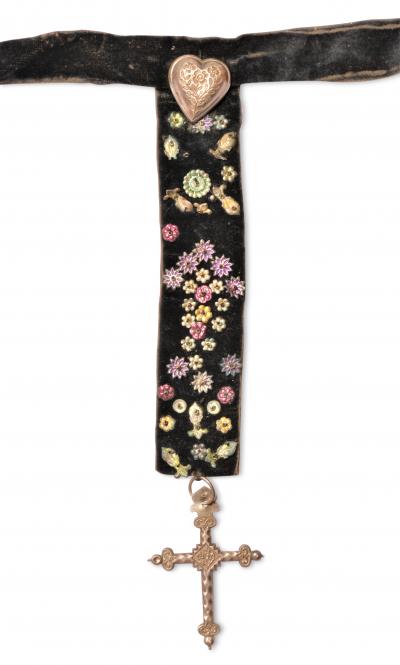
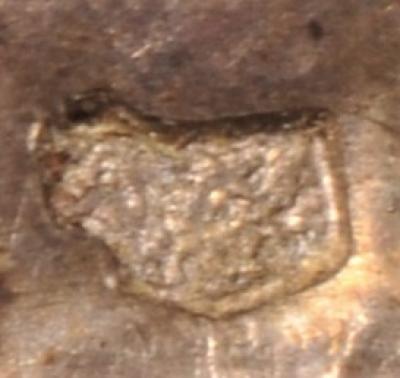
silver "Jeannette" cross from Brittany with its sequin spangled velvet ribbon
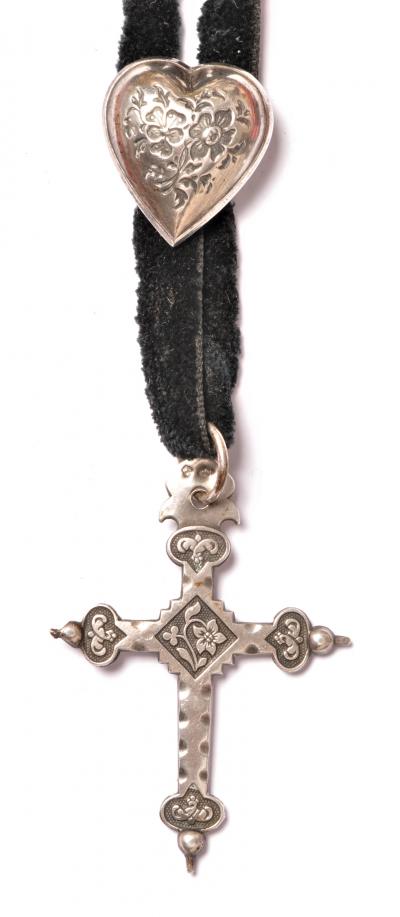
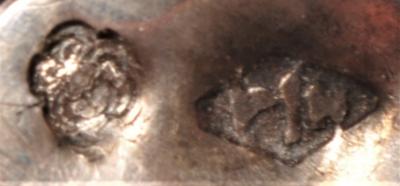
silver "Jeannette" cross from Brittany with its velvet ribbon
The Brittany cross
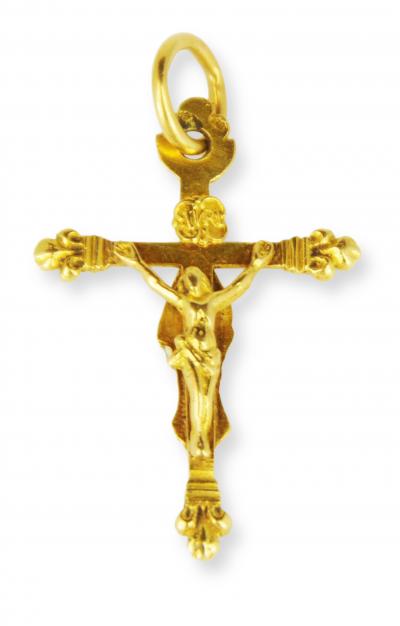
gold cross from Brittany, front |
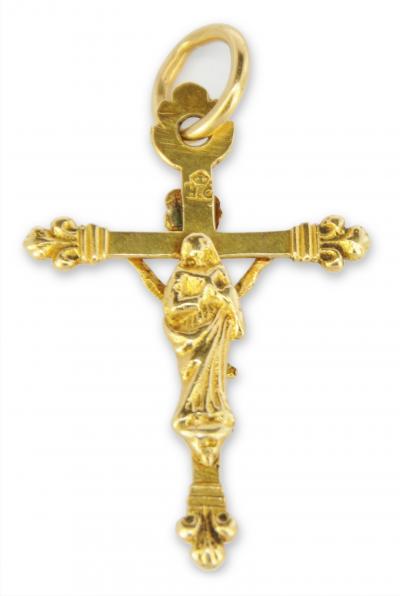
gold cross from Brittany, back |
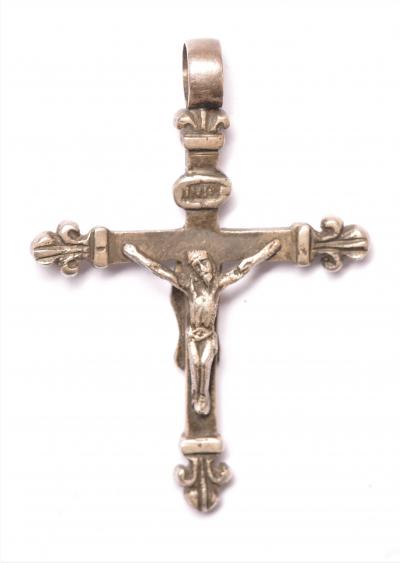
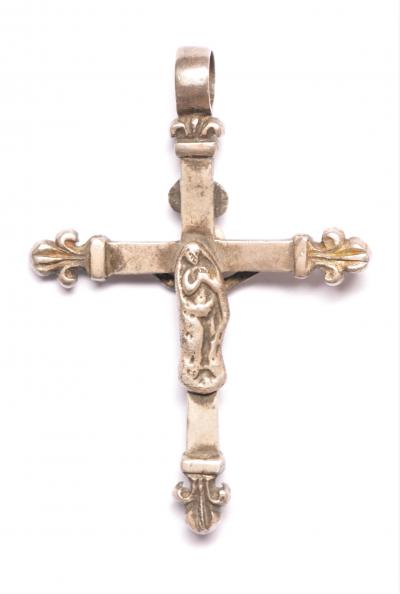
Silver cross from Brittany, front and back view
The reliquary cross
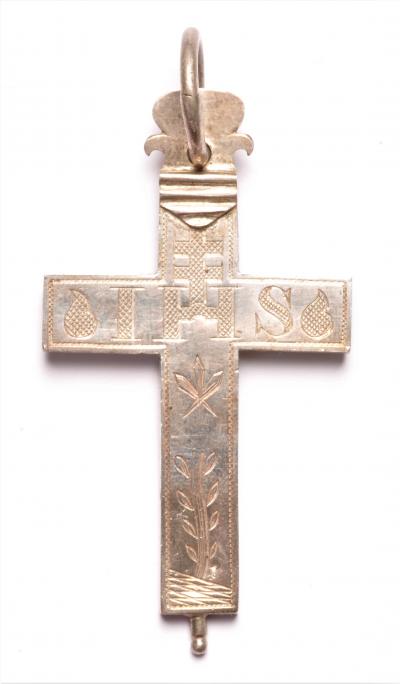
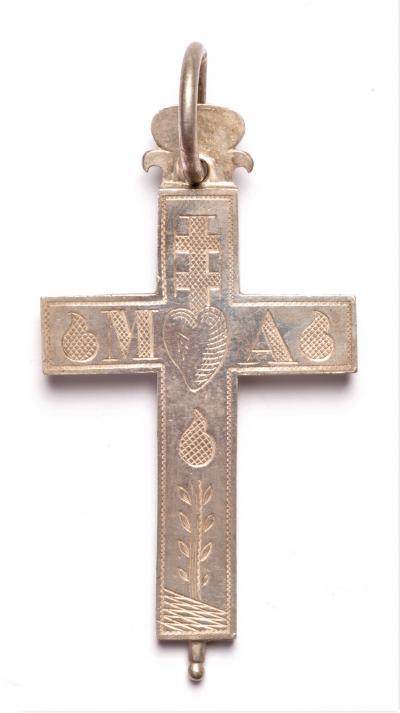
reliquary cross in silver, front and back view
The traditional Breton reliquary crosses are engraved with the acronyms IHS and MA as well as various objects of the Passion of Christ, the arma christi which can include the three nails, three tears, the sponge, the ladder, the spear, the rooster of Saint Peter, the hammer, the pincers, the dice of the soldiers, the shroud, the columns of the flogging, the lantern of the arrest of Christ, the red coat of the flogging and the crown of thorns. Sometimes hanging from these crosses we observe three spherical pendants threaded on a hooked silver wire.
|
|
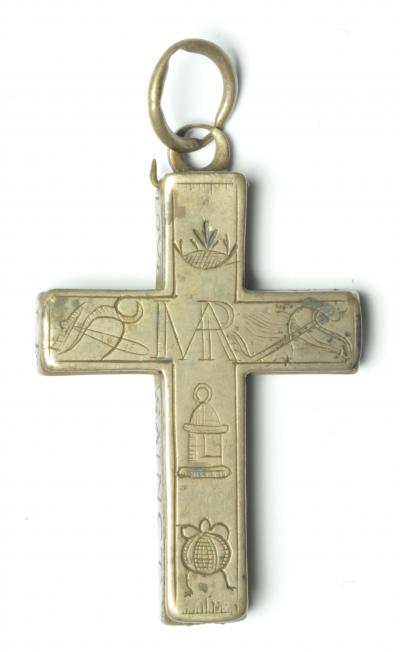
silver reliquary cross, front |
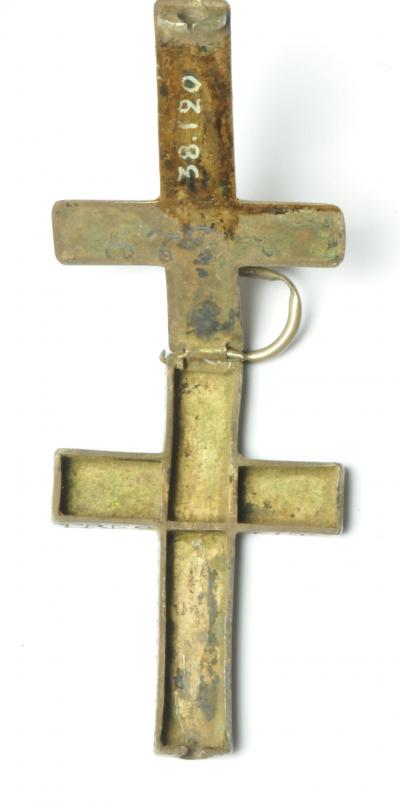
silver reliquary cross, open |
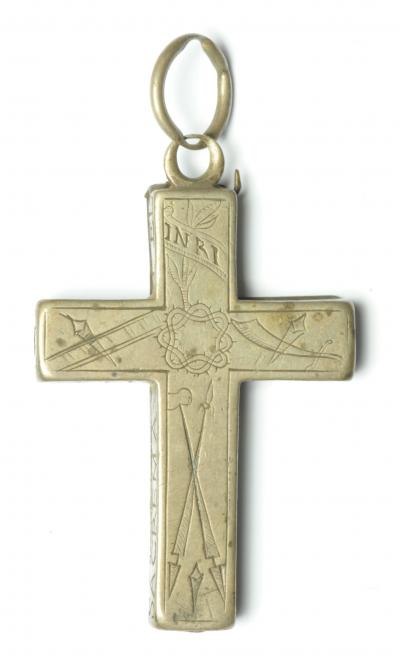
silver reliquary cross, back |
|
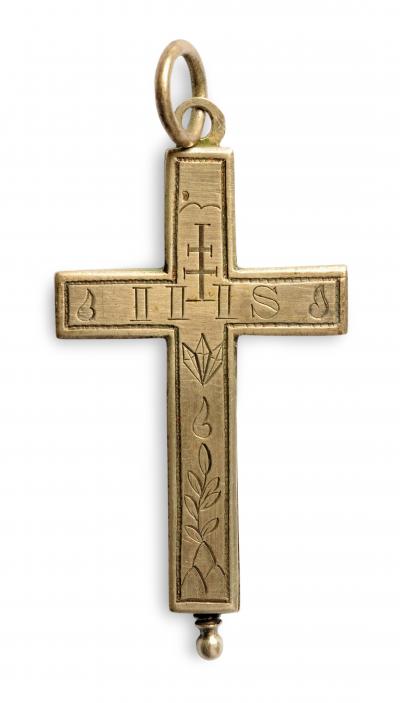
silver reliquary cross, front |
|
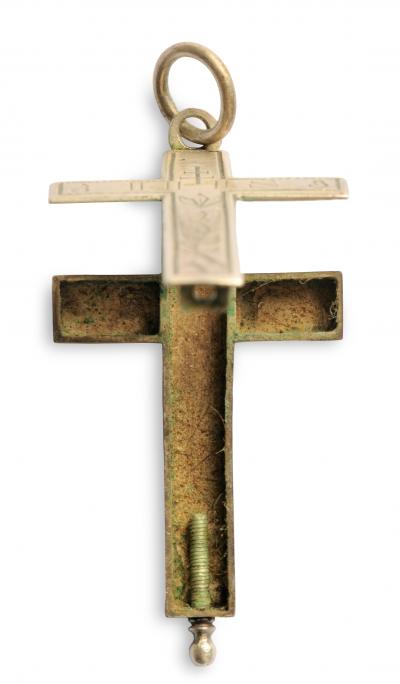
silver reliquary cross, open |
|
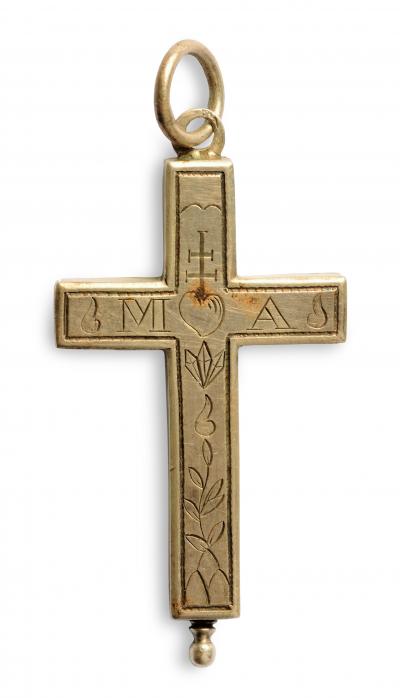
silver reliquary cross, back |
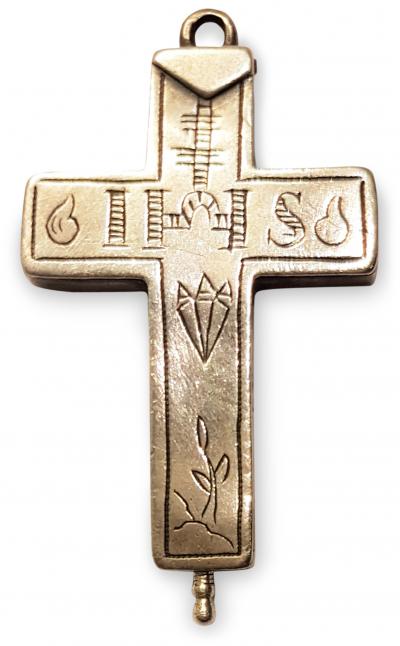
silver reliquary cross, front |
|
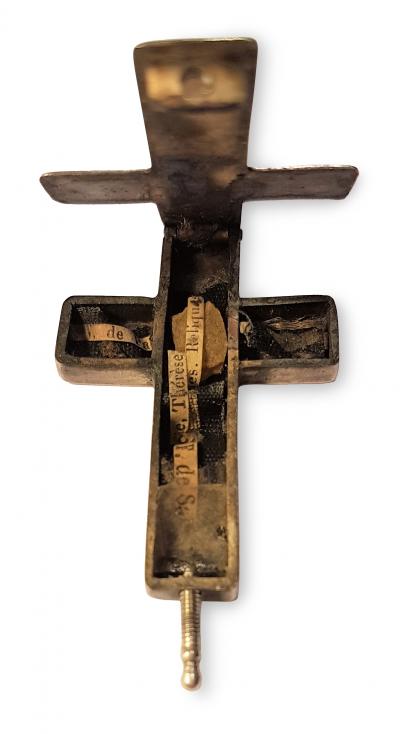
silver reliquary cross, open |
|
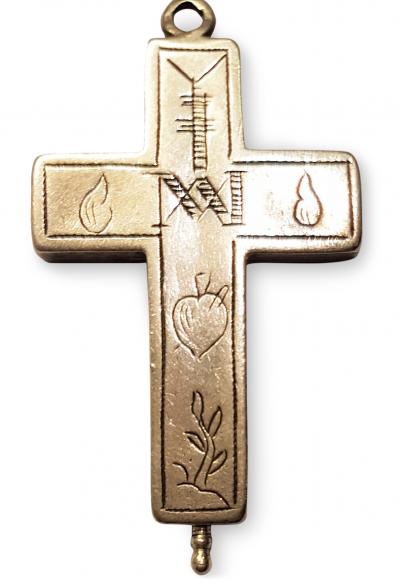
silver reliquary cross, back |
The following two reliquary crosses from Brittany are more recent and were probably made primarily for the tourist market.
|
|
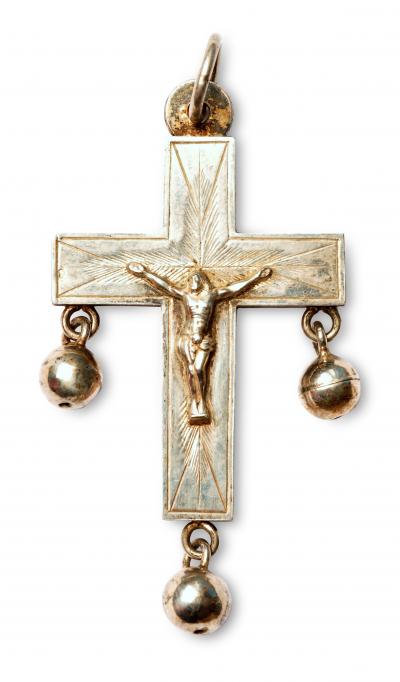
reliquary cross in silver, front view |
|
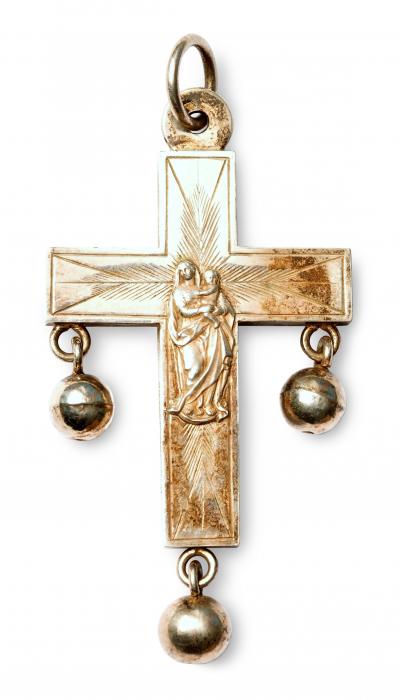
reliquary cross in silver, back view |
|
|
|
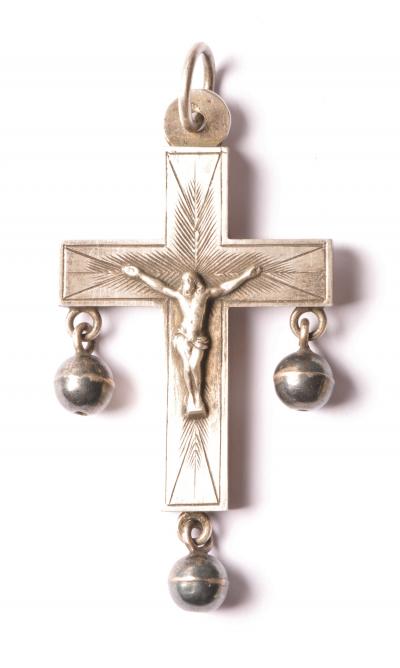
reliquary cross in silver, frontview
|
|
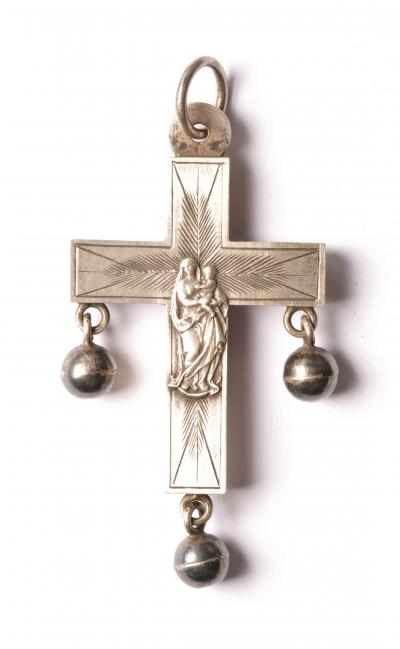
reliquary cross in silver, back view
|
|
The cross from Bourg en Batz
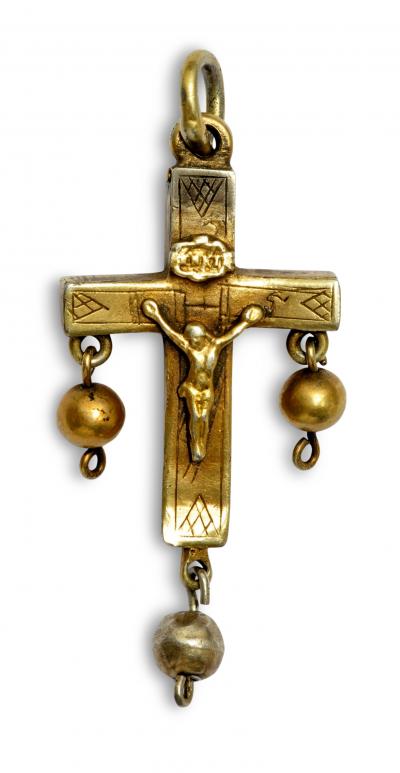
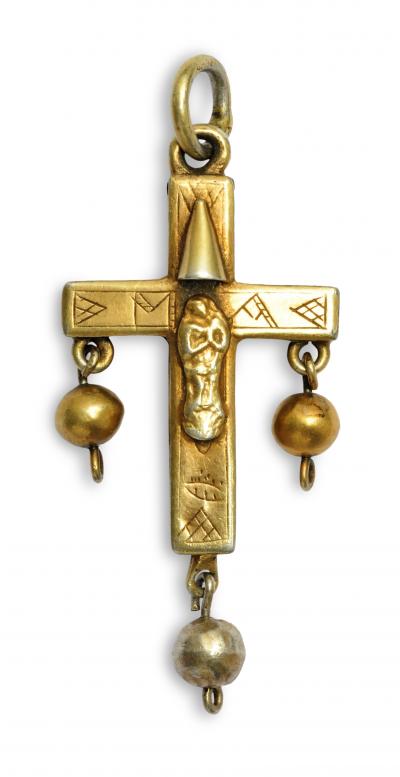
Bourg en Batz reliquary cross in silver gilt
The Bourg en Batz reliquary cross can be recognised by its design of engraved triangles, the hanging spheres ending with a visible loop in the wire and the representation of Mary with clasped hands under a canopy. The examples shown here are reliquary crosses which open to reveal compartments to hold relics. I find these reliquary crosses, while rare, to be encountered too often today to have Bourg en Batz (today called Batz-sur-Mer, population 3,000) as their sole source and I suspect they were in fact used elsewhere in Brittany, which is only a few miles away, or pehaps sold widely to tourists at the end of the 19th century. Racinet included a Bourg en Batz cross for his illustration of jewels from Brittany in his monumental 'La Costume Historique'; see the extract at the top of this page.
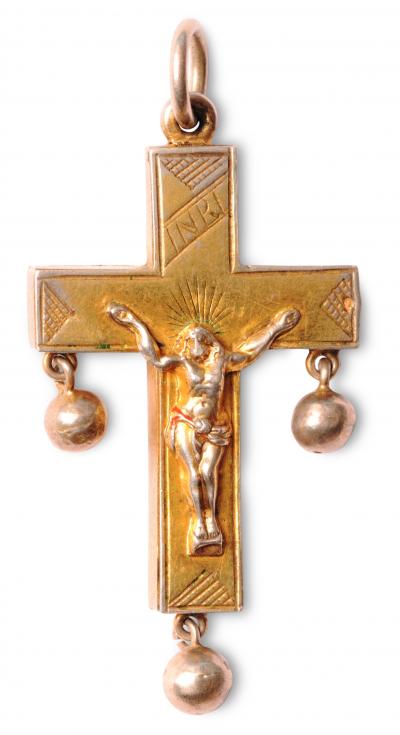
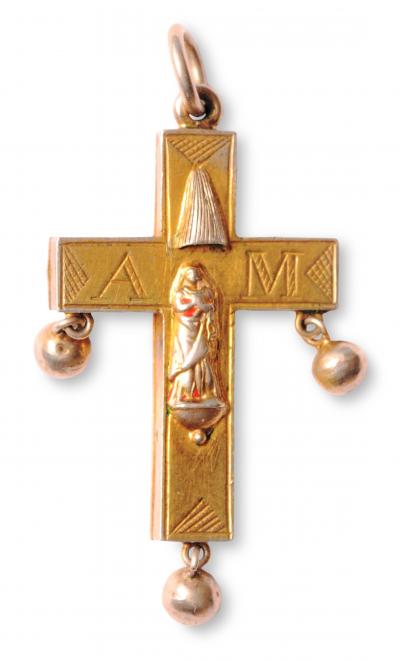
Bourg en Batz reliquary cross in silver gilt
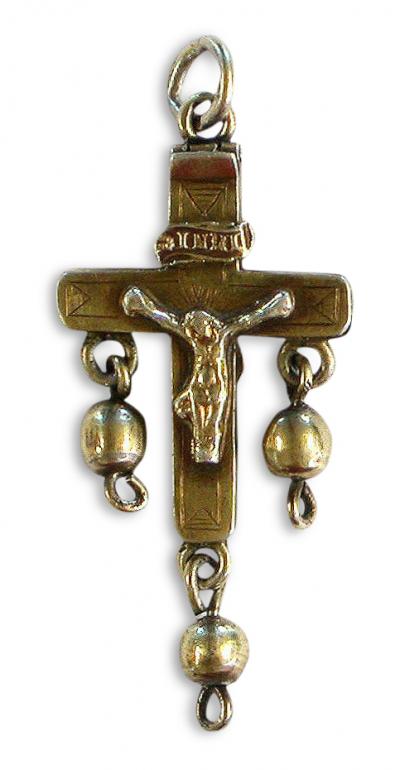
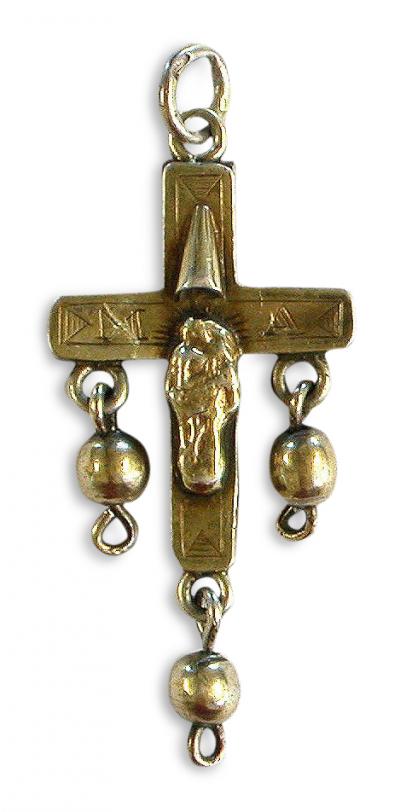
Bourg en Batz cross in silver
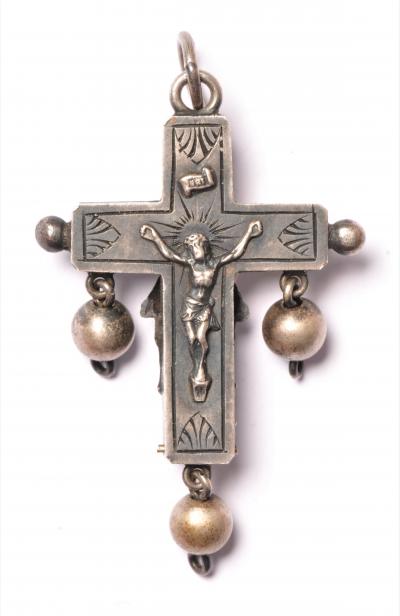
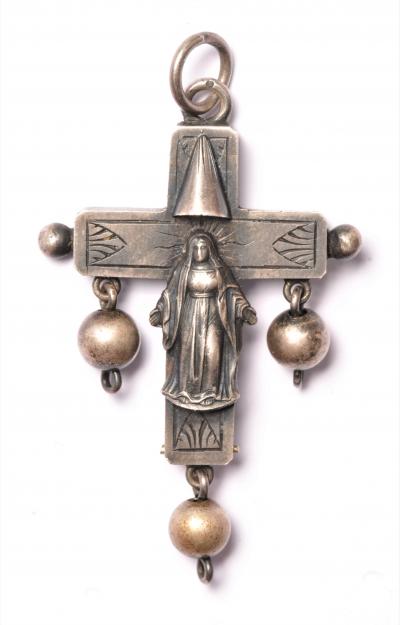
Bourg en Batz cross in silver
The Finistère cross
two Finistère crosses in silver and silver gilt
One can observe that the extremities of the Finistère cross, varies between a simple tri-lobed clover motif, a fleur-de-lys motif and the double spirals that are characteristic of the abbesse crosses from the Champagne region. The branches of the cross are flat and smooth with three or four pointed rays radiating from the centre. Fitted to the obverse is an image of Christ, on the reverse the Virgin and Child on a pedestal.
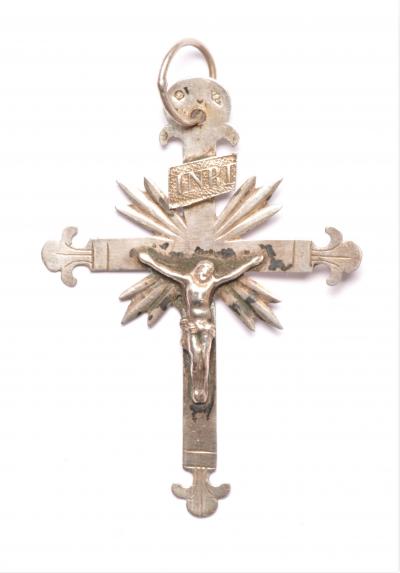
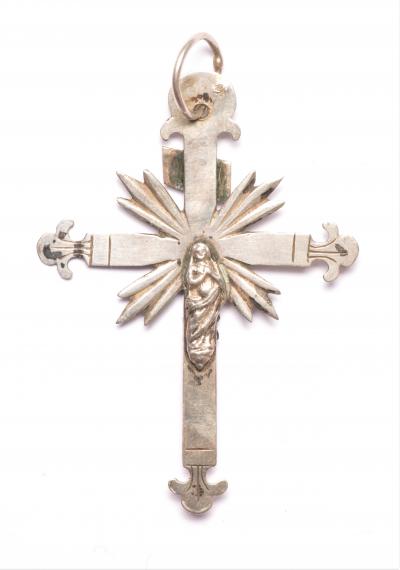
Finistère cross in silver
BIJOUX REGIONAU
The "heart of Saint Anne" cross
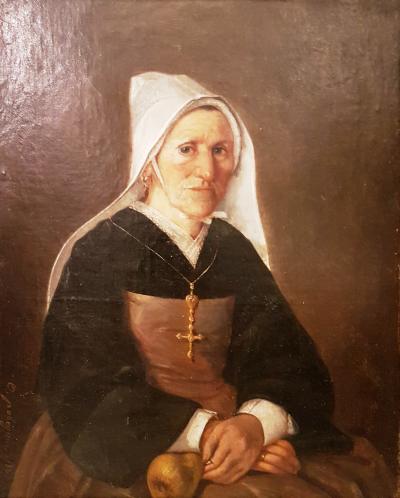
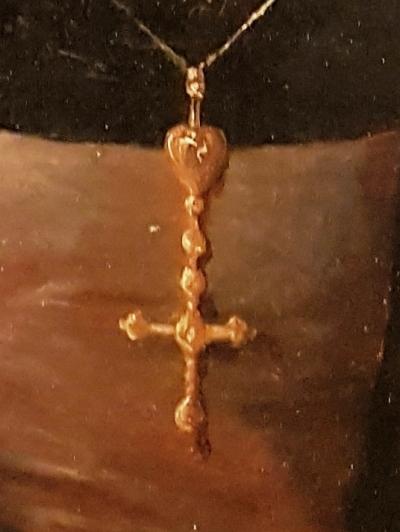
peasant woman from Vannes wearing the heart of Saint Anne cross, by O. Pobéguin, 1857
The pardon fibulae
|
|
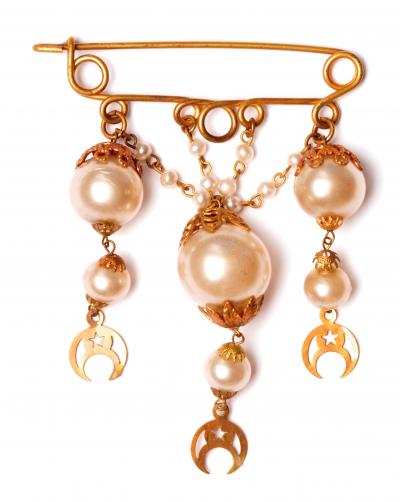
pardon fibule in brass and glass |
|
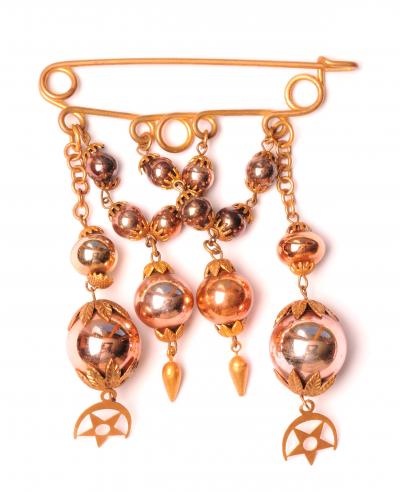
pardon fibule in brass and glass |
|
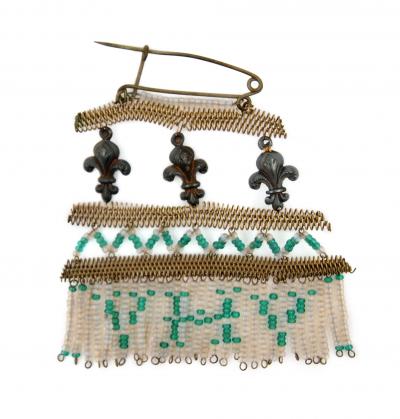
Pardon fibula in silvered brass and glass beads
The beads spell out the letters V.H.V (Vive Henri V) or Long live Henry V, and was worn by a supporter of Henry the Fifth, pretender to the French throne around 1879.
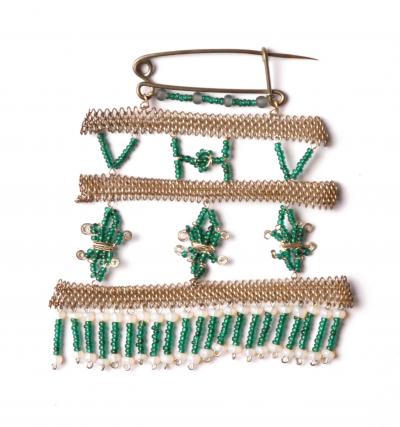
Pardon fibula in silvered brass and glass beads
The pardon brooch or pin
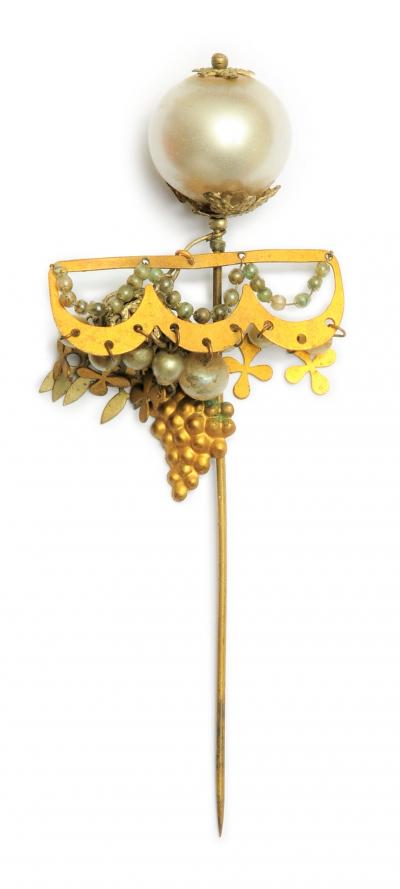
pardon pin in gilt brass and glass pearls
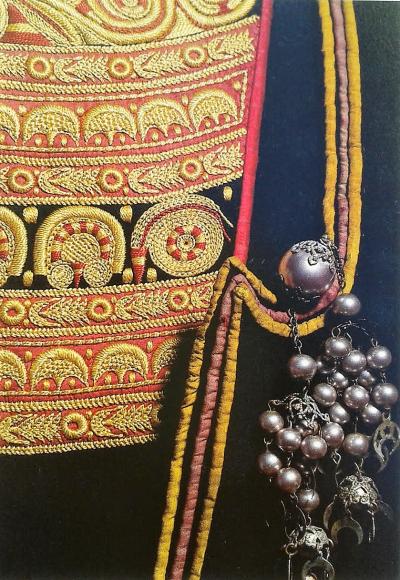
pardon pin in silvered brass and glass pearls on a corsage bigouden in the museum of Quimper.
click on the photos to enlarge them in high resolution
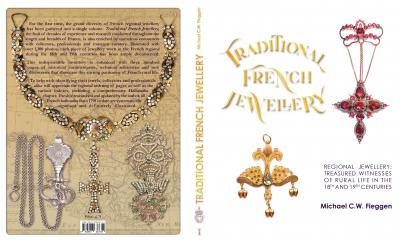
Many other pins and fibulae not visible on this website can be found in the book Traditional French Jewellery, in English - You can order it here direct from the author
Shirt or smock clasp
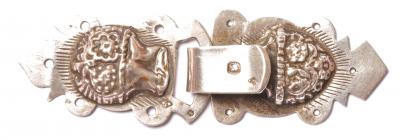
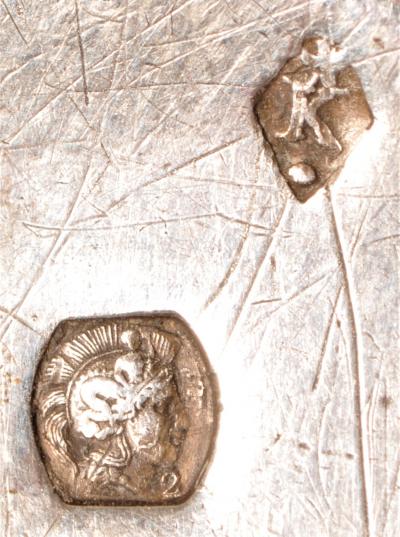
clasp in silver for a man's work smock
The smock or shirt buckles of this shape, in silver and with five fixing perforations, are typically Breton and always hallmarked in Brest.
Shit buttons
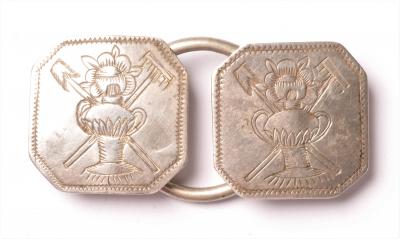

antique silver shirt buttons, hand engraved
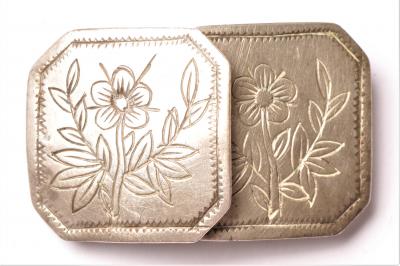
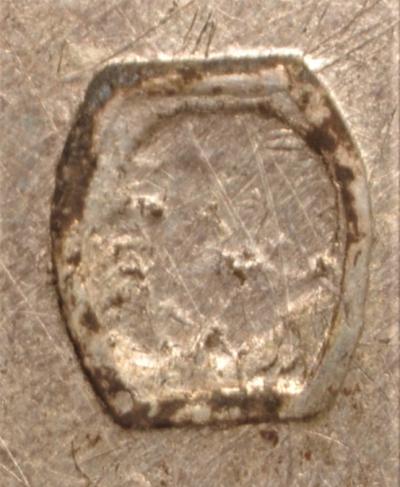
antique silver shirt buttons, hand engraved
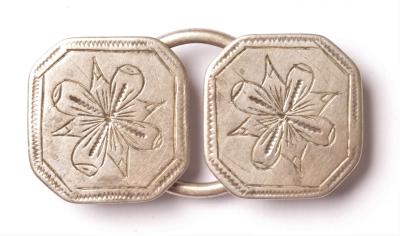
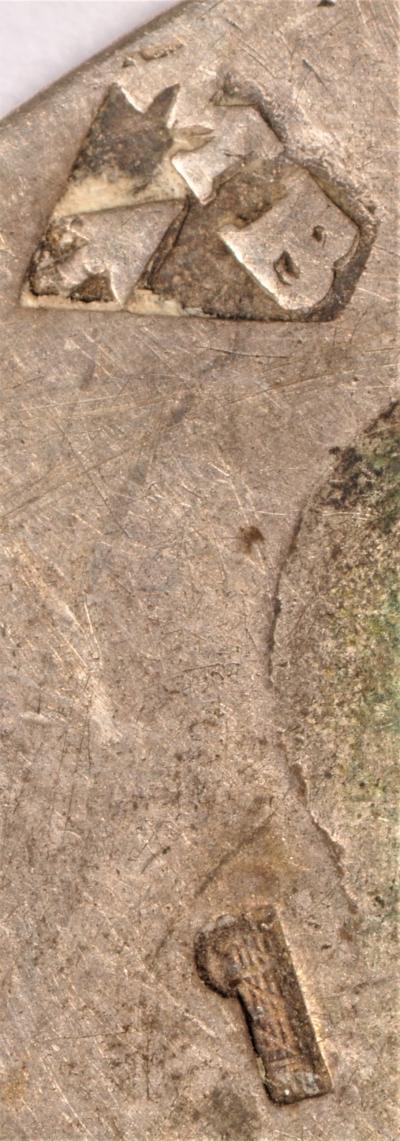
antique silver shirt buttons, hand engraved
The wedding cup
In Brittany, the bride was offered a wedding cup in silver or engraved glass for drinking during the ceremony; for the less fortunate families the cup was made of pewter. The Brittany wedding cup was usually engraved with the wife's name or her initials. This wedding cup was later used for everyday use as well as during baptisms and communions and eventually placed in front of the coffin of the deceased and filled with holy water ...
The family usually offered a beaker or wedding cup to the woman and a wine cup (tastevin) to the man. In the past, one had to bring one’s own cutlery and tableware if one wanted to eat out and the flat shape of the tastevin was designed to be easily transportable in a pocket. For more modest people, the cups and tastevins were made of pewter or even wood.
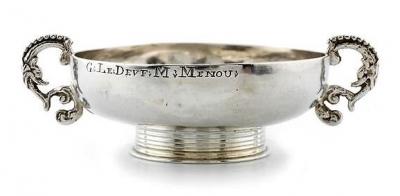
wedding cup from Brittany in silver, 1716-1717
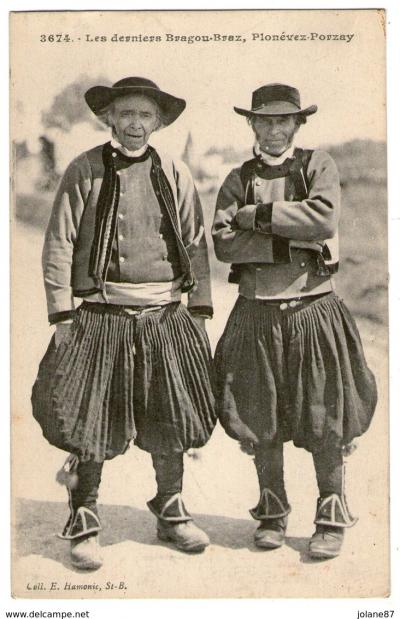
homme avec boten-bragou fermant son bragou
The boten-bragou is a double button formerly used by men to close their bouffant trousers (bragou) and is carved from a single piece of boxwood.
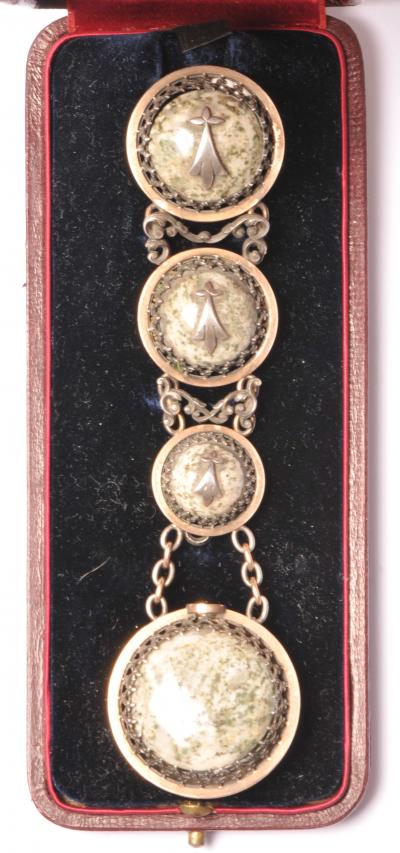
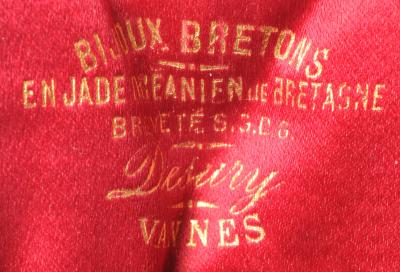
a chatelaine to hold a pocket watch in gold plated silver and "ocean jade" from Brittany made by Auguste Hippolyte Désury, Vannes.
a non traditional jewel made for the tourist market
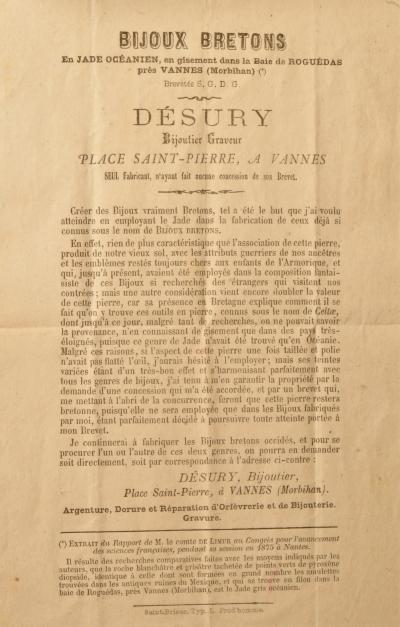
Breton jewellery today
Regional jewels are still popular today in Brittany but their shapes and their goals have changed. Popular with the younger generation and tourists, usually in silver, they consist of various Celtic patterns mixed together in many forms so as to sell well. They have no ancestor and have no other purpose than to mark the affection that the wearer has for Brittany. The motif of the triskelion is very popular and while its origin goes back to the Celts, its meaning is widely disputed and has innumerable interpretations, generally based on three elements such as earth, wind and fire, etc. The Celts did not have a written language, so the true meaning they attributed to the triskelion will never be known. However I like to imagine that it could have been what is still given today on the Isle of Man where the triskelion is the symbol of the island. It is less stylized, with three human legs radiating from a central point and the motto is "I always fall on my feet".
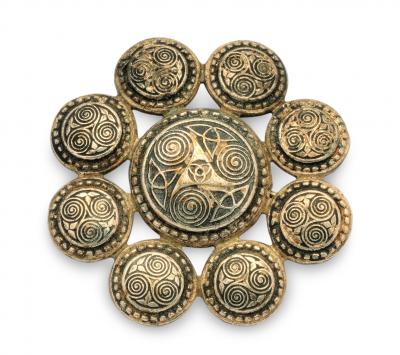
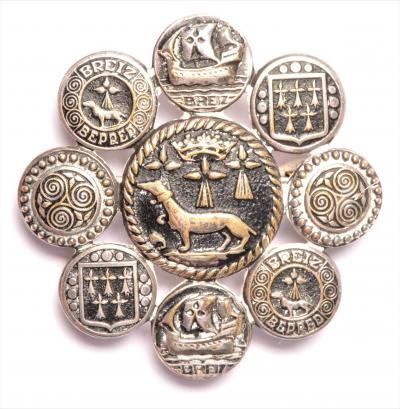
modern breton brooches with symbols of triskelion and ermines, silver plated a
two modern Breton heart pendants and a brooch in silver
|
|
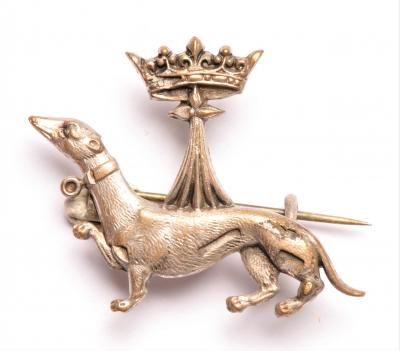
Breton ermine brooch, modern,
silver plated |
|
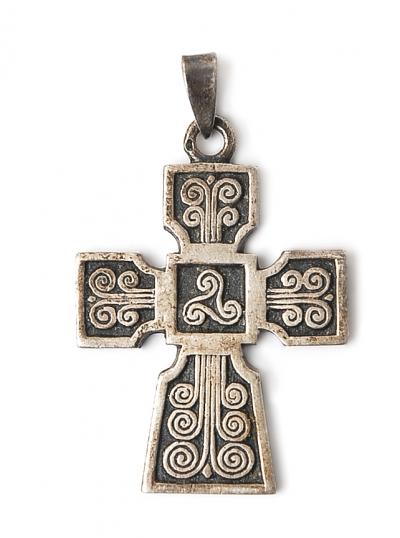
modern breton cross in silver
|
|
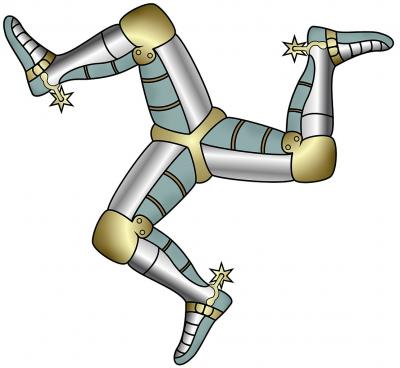
the Triskelion is the symbol of the l'Isle de Man - "I always fall on my feet"
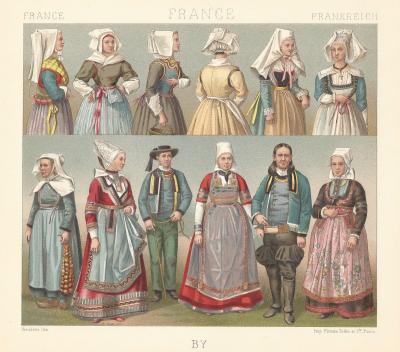
Traditional folk costumes from Finistère in Brittany according to Racinet in La Costume Historique
click on the photos to enlarge them in high resolution
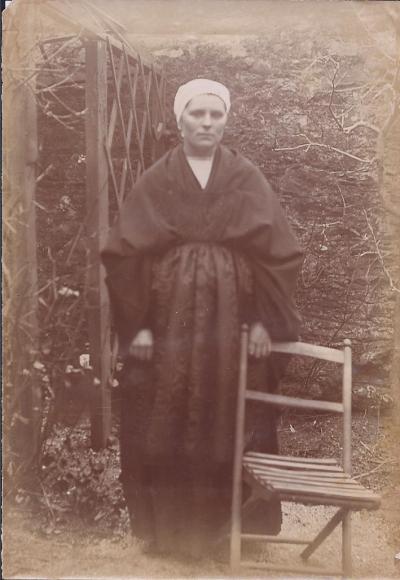
coiffe and folk dress from Brittany - Lannion
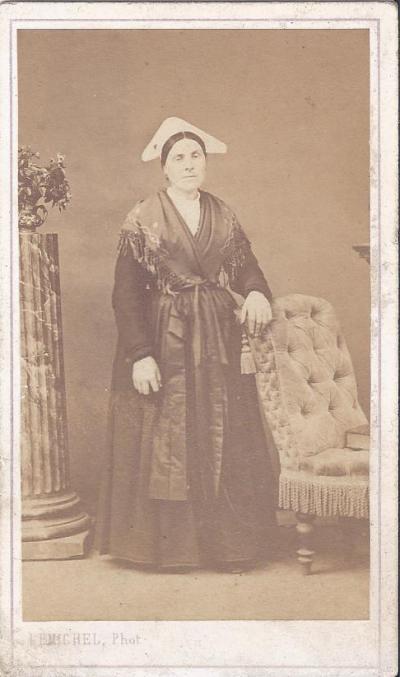
coiffe and French folk dress from Brittany - antique photo |
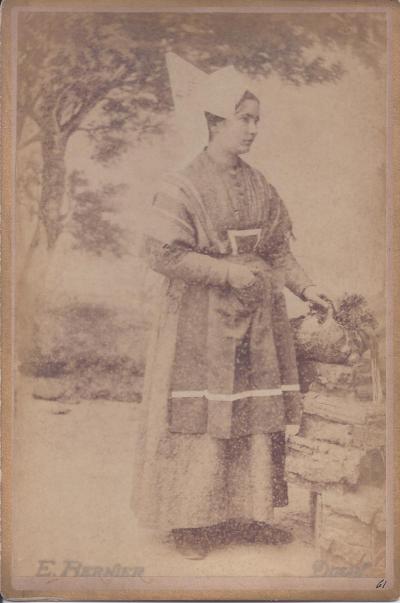
coiffe and folk dress from Brittany - Lannion |
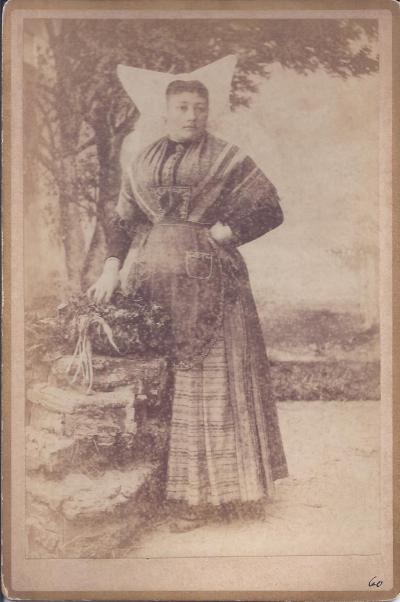
coiffe and folk dress from Brittany - Lannion |
|
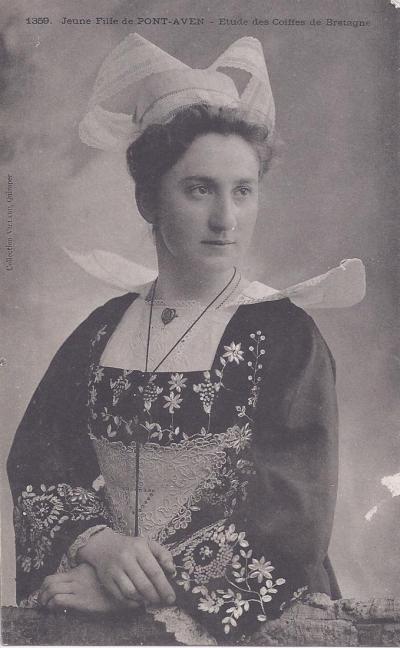
French regional costume and jewellery
Pont Aven, Brittany
|
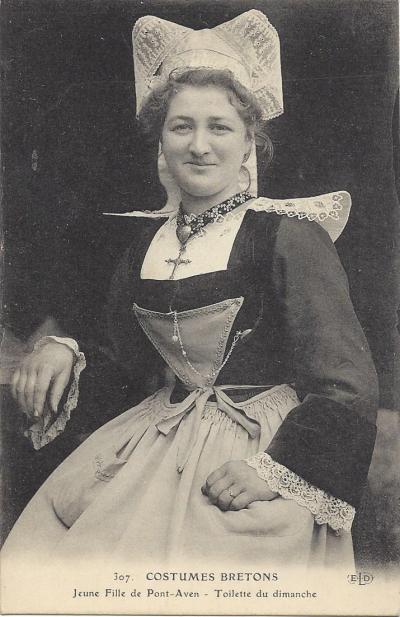
Sunday dress from Pont Aven, Brittany
|
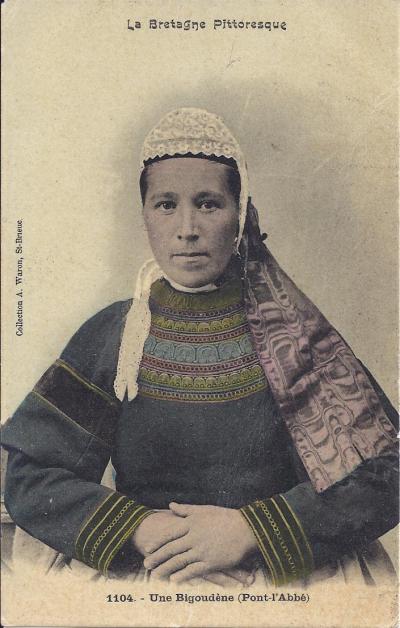
coiffe, costume and jewellery, Pont l'Abbé in Brittany |
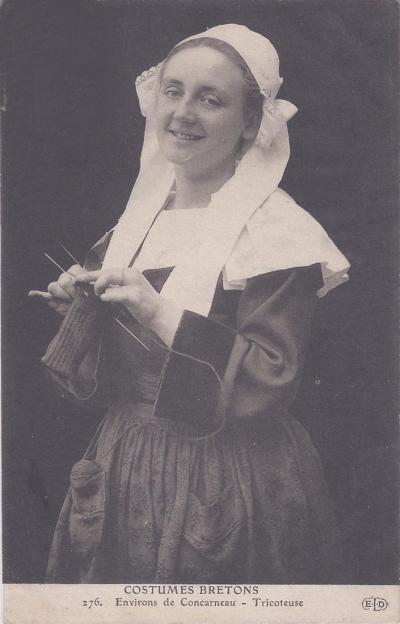
French regional costume - Concarneau, Brittany |
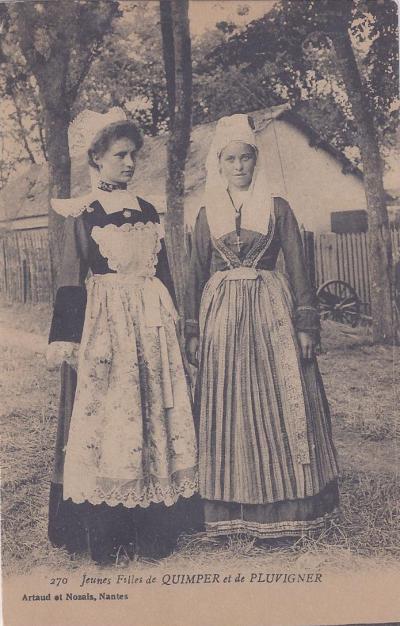
French regional costume and jewellery
Quimper & Pluvigner, Brittany |
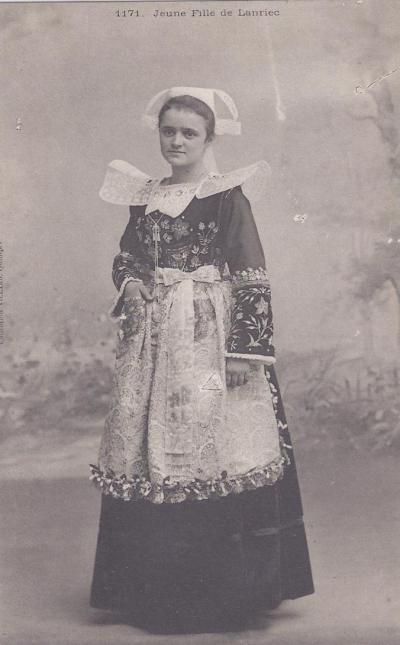
richly embroidered French regional costume
and jewellery from Lanriec, Brittany |
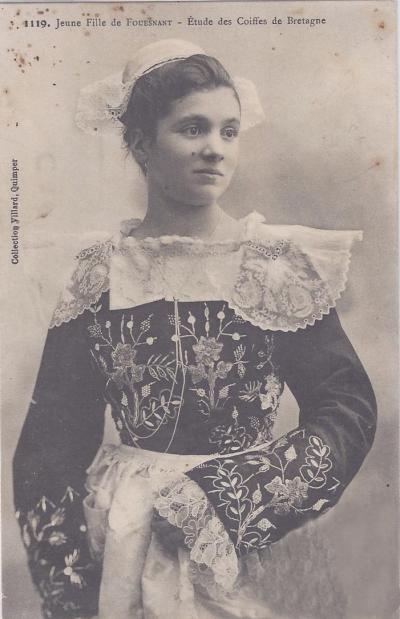
finely embroidered French regional costume
and jewellery, Fouesnant, Brittany |
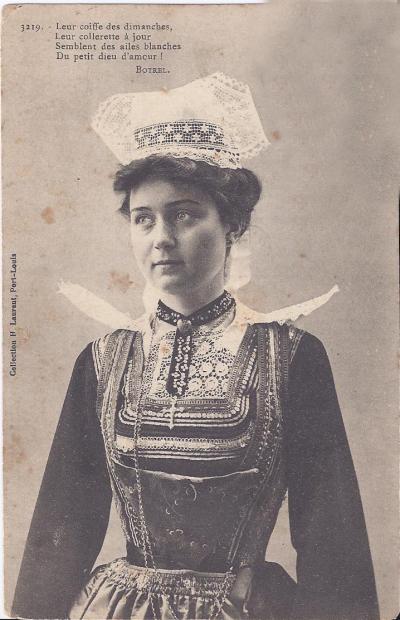
French regional costume and jewellery - Brittany
|
|
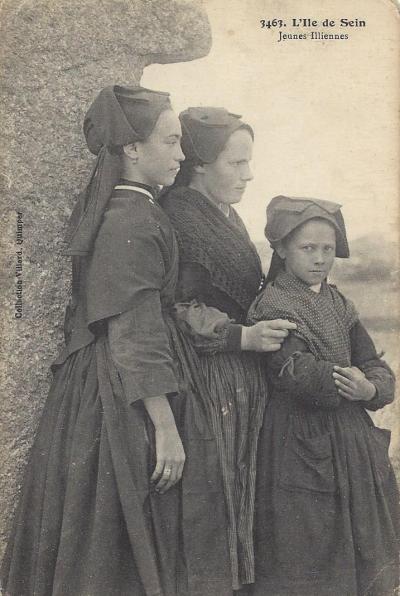
coiffes and French folk-dress from Brittany
Sein island
|
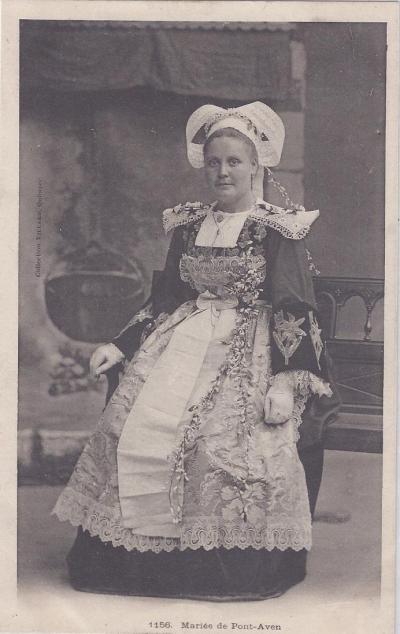
French regional folk costume and jewellery
Brittany |
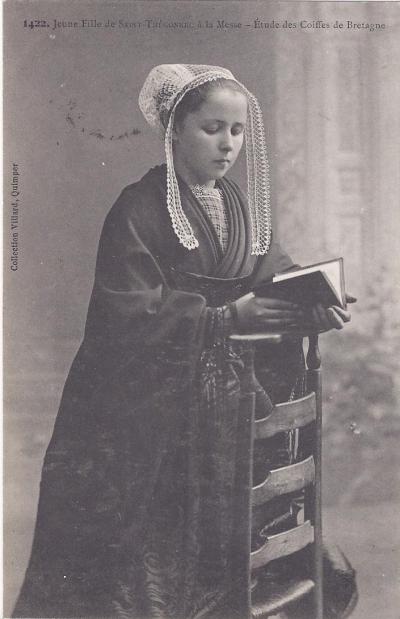
French regional costume and jewellery
Saint Thégonnec, Brittany |
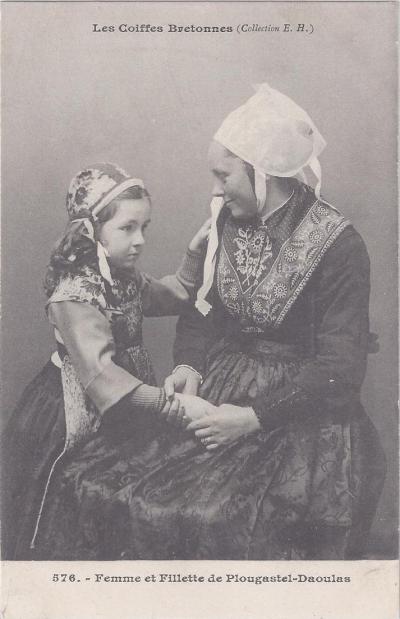
French regional costume and jewellery
Plougastel-Daoulas, Brittany |
|
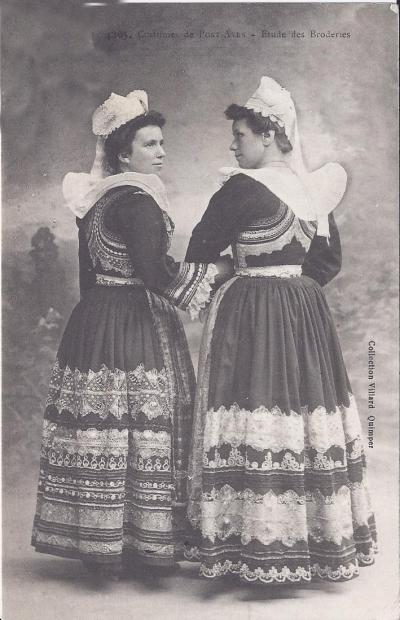
French regional costume and jewellery
Pont Aven, Brittany
|
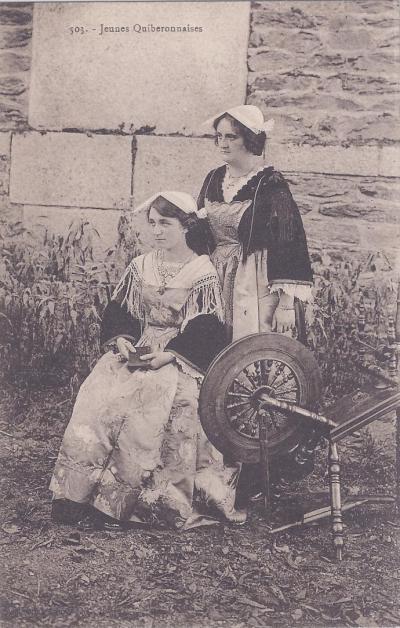
French regional costumes and jewellery
Quiberon, Brittany |
|
|
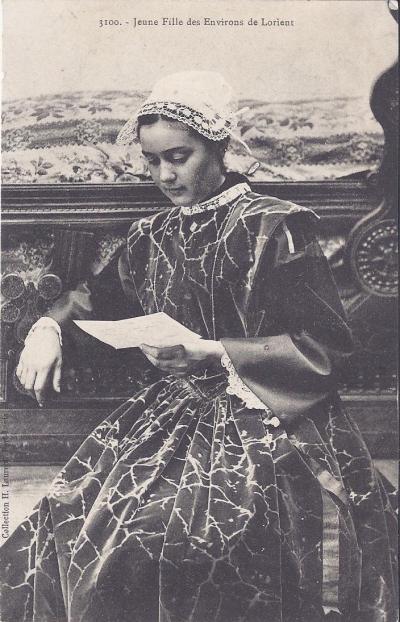
regional costume Lorient, Brittany
|
|
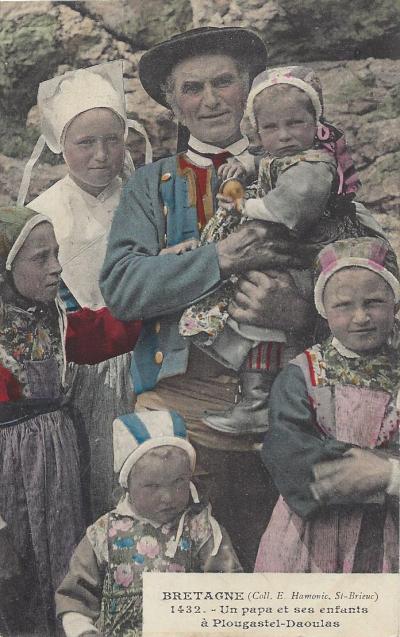
regional costume from Plougastel-Daoulas, Brittany
|
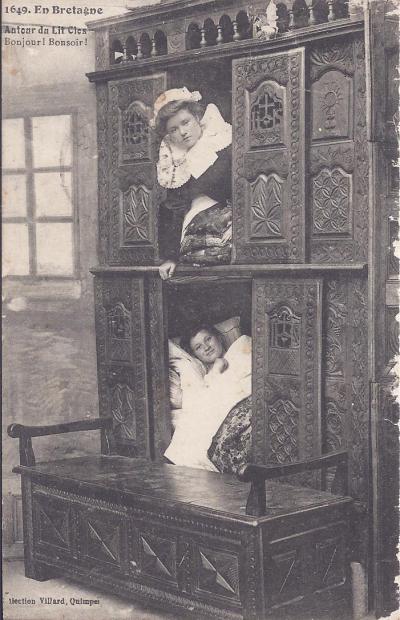
closed wooden beds used in Brittany to protect from cold winter nights |
Contact me with your suggestions, corrections, photos, questions and comments!
contents:
croix bretonne - croix d'Alsace - broche alsacienne - croix de Lorraine - bijoux des régions de France - les bijoux des Français - les bijoux de France - bijoux régionaux - bijou régional - croix écotée - pendentif Saint Esprit - Saint Esprit d'Aurillac - rose de Velay - collier d'esclavage - croix de Puy en Velay - croix d'Auvergne - bijoux d'Auvergne - bijoux auvergnat - collier Saint Esprit de Puy en Velay - croix de Velay - bijoux d'Auvergne et du Velay - costume regional - bijoux régionaux - coiffe - coiffe auvergnat - bijoux des régions de France - bijoux régionaux - les bijoux traditionnels Français - croix régionales - Léon Giron - Antoine Raspal - Thomas Desgeorge - Estella Canziani - esclavage auvergnat - Coiffes et costumes de Bretagne par François de Beaulieu - antieke zeeuwse streeksieraden in zeeland friesland - Brabantse klederdrachten en streeksieraden
French regional jewellery - Brittany
New book - Traditional French Jewellery

Book - Traditional French Jewellery - order here direct from the author
Dear collectors, auctioneers, dealers and jewellery lovers,
You have visited the site www.bijouxregionaux.com which since 2009 has listed all regional and traditional French jewellery, without advertising and without sales. By popular demand, this website is now finally available as a book, much more complete and with many new photos and texts that are not on the site. I traveled more than 4,500 km in 2020 to visit the various collectors and museums of France and to photograph, weigh, measure and examine their jewellery.
Large format of 23.5 x 30 cm, 304 pages, hardcover and fully illustrated with over 1300 jewels in color, this book is the first complete book on French regional jewellery and corrects the many errors and gaps observed in the other references and presents other regional jewels hitherto unknown to the public. You will find eight full pages on Breton pins and fibulae and many other jewels in museums and private collections that are not on this website. Over four months of research has gone into making the chapter on hallmarks the most reliable ever seen - clear illustrations of hallmarks have been made especially for this volume. And for the first time, collectors will have access to a complete list of all the assay office symbols, small signs withn the hallmarks that identify in which city the jewellery was hallmarked. The opening and closing dates since 1798 of the hallmark offices are also listed for the first time, allowing, with the office symbol, to better date your jewellery.
The print run of this book is very limited, which is why I recommend you order early. You will love this book I have had nothing but compliments and many clients have ordered more to offer as gifts.
To order, you can send a wire transfer or WISE transfer to Michael Fieggen - FR76 4061 8803 9700 0403 3233 171 – BIC – BOUSFRPPXXX - address Mike Fieggen, 280 rue Saint Honoré, Paris, 75001 France
Bank or wire transfer by www.wise.com in Sterling – Account holder - Michael Fieggen
IBAN - GB68TSBS30916200184462 BIC / SWIFT - TSBSGB2AXXX
Sterling cheques and PayPal welcome to address demosthenesparis@gmail.com.
Any questions ? Contact me at bijouregional@gmail.com or by telephone at + 33 1 4015 9000
One copy in French €75 Postage and packing €9 for France, €8 for Europe and overseas
Two or more copies in French €75 each Postage and packing €9 for the lot in France, overseas postage €8 each
One or more copies in English £75 sterling each Postage and packing £8 sterling each
















































